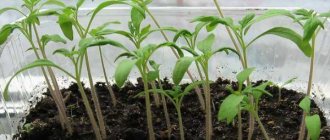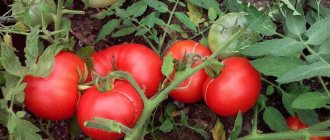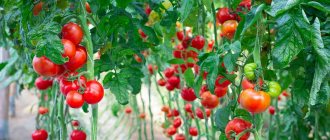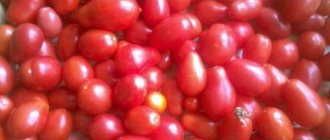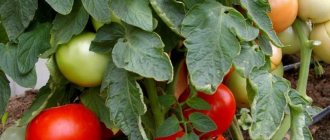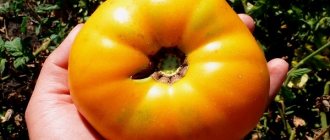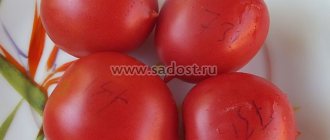White filling is a valuable tomato for those who like to eat fresh tomatoes at the beginning of summer. Agricultural technology is simple; both professionals and beginners can handle cultivation.
| Height | Landing location | Ripening time | Fruit color | Fruit size | Origin | Fruit shape |
| Medium height | Greenhouse, Open ground | Early ripening | Reds | Average | Hybrid | Round |
Description of tomato White filling
The White filling tomato variety can reach a height of 0.5 m if grown in open soil. When the plant is cultivated in a greenhouse, it can grow up to 0.7 m. The variety is determinant. This means that it does not have the ability to grow beyond these limits. The type of shrub is not standard.
The root system of this variety is very powerful. It can grow to the size of a bush itself.
The foliage of the plant is medium in size. It is painted in light green color. The leaves have a wrinkled structure. There is no pubescence on tomato leaves. There is no white filling.
The inflorescence of the White filling variety is simple. Type of location – intermediate. The very first inflorescence is formed above the 6th leaf, the rest are located every 1-2 leaves. There are at least 3 flowers on it.
The strong stem has a stalk on which there is an articulation. White filling tomatoes are securely fastened and are not subject to falling off.
This variety can be classified as early ripening. Ripe vegetables can be harvested within 2.5-3 months after the sprouts sprout if they are grown in a greenhouse. In open soil, the crop will be ready for harvest after 3.5 months.
Description of fruits
Tomato fruits White filling 241 have a round, slightly ribbed and slightly flattened shape. One tomato can weigh approximately 100 g. Their diameter varies between 6-8 cm.
The surface of vegetables is characterized by smoothness and dullness. The skin of this variety is quite thin. When the fruit is not yet ripe, it has a light green color. When ripe, it turns red.
The pulp is characterized by meatiness and juiciness. It contains approximately 5% dry matter.
Description of the variety
White filling was first tested in 1969, in Kazakhstan. The variety has a number of advantages: early ripeness, resistance to cold, high yield.
Variety characteristics:
- It belongs to the determinant type, that is, it has limited growth. This means that as soon as an ovary with fruits forms on the shoot, it stops growing further. Thus, the gardener does not need to trim unnecessary empty branches that take away juice from fruit-bearing branches.
- The stem is strong, in open ground it grows up to 50 cm in length, in a greenhouse - up to 70 cm. The roots are powerful and spread up to half a meter wide.
- The leaves are light green , medium in size and have no villi.
- The fruits are round in shape and red in color. When ripe, the color is milky white, which is what gave the variety its name. The pulp is dense, fleshy and juicy, with a slight sour taste.
- Since the peel is dense and the weight of one tomato reaches 120 g, this variety is considered one of the best for canning .
- The variety is considered a record holder for early ripening, as it ripens early and quickly. Only about three months after planting the seedlings - and you can harvest.
Characteristics of tomatoes White filling
Judging by the reviews and photos, the White filling tomato has good yield. By following all the rules of care, you can harvest approximately 3 kg of tomatoes from one bush.
Productivity and fruiting
If you believe the description of the variety, White Naliv tomatoes are suitable for harvesting and consumption already on the 100th day when cultivated in open soil. When growing a plant in a greenhouse, tomatoes will ripen in 80-90 days.
Area of application of fruits
Tomatoes have a very pleasant taste and aroma. Although the White filling variety was bred specifically for processing, they are still consumed fresh. Tomatoes of this type are great for making salads, soups, stews, etc. They also make good preparations in the form of sauce, ketchup, tomato paste and juice. However, in the reviews, some claim that White filling tomatoes are not suitable for juice, as it turns out to be thick. Vegetables can be canned without fear of them cracking.
Resistance to diseases and pests
White filling tomatoes have good resistance to diseases that often affect shrubs of other varieties. The plant is predisposed to late blight, but it does not have time to get sick due to its early ripening. The culture has absolute immunity against macrosporiosis (dry spotting).
Shrubs may be attacked by Colorado potato beetles.
Advantages and disadvantages of the variety
The tomato variety White filling 241 has many advantages. These include the following characteristics:
- excellent taste and aroma of fruits;
- short ripening periods;
- ease of care;
- undemanding to weather conditions;
- average resistance to diseases and insect pests;
- attractive appearance of tomatoes.
The only disadvantage that can be noted is that the crop is still susceptible to some diseases and pests. You won't have to deal with this problem if you provide the shrubs with the minimum care they need.
Advantages and disadvantages of the variety
Tomato White filling is an old proven variety. The plant is easy to care for, so it is suitable for beginner gardeners.
pros
- early maturation;
- beautiful round fruits;
- stable yield;
- cold resistance;
- widely zoned;
- universal purpose;
- Thanks to the dense skin, the fruits do not crack and are easily transported.
Minuses
- low resistance to diseases;
- tomatoes ripen unevenly, which is inconvenient for preparations;
- During storage, taste quality decreases.
From ripe tomatoes you can take and prepare seeds for planting for the next season.
The sweet and sour taste of White filling tomatoes is not suitable for everyone, especially those who like a more pronounced shade in tomatoes.
Growing rules
Even before planting seeds for seedlings, they need to be properly prepared by following these steps:
- Place the planting material in a solution of potassium permanganate. After a quarter of an hour, wash it under cool water. This stage is necessary in order to disinfect the seeds.
- Prepare a solution by diluting 10 g of nitrophoska in 1 liter of water. Immerse the planting material in the liquid. This step is necessary for the successful growth and development of the plant.
- Place the seeds in moisture. The temperature should be approximately 25-30°C. The procedure should last 1-2 days, it will help the material to germinate.
Planting seedlings
The soil for planting seeds for seedlings must contain nutrients. In addition, you must make sure that the soil has a neutral acidity level. Before planting the material, the ground should be dug up using peat or humus. It can also be fertilized with potash or superphosphate.
Stages of planting seeds for seedlings:
- Buy a container for seedlings made of plastic or wood.
- Pour into it a soil mixture containing useful substances.
- Make small depressions 1 cm in size in the soil. The holes should not be closer to each other than 1 cm.
- Place planting material in the holes, sprinkle it with soil and water it.
- Cover the container with glass or plastic wrap.
- Place the future seedlings in a warm and well-lit room.
After 10-14 days, the first shoots will appear. Then the container will need to be moved to a place with a lower temperature. It should also be light. The material with which the container was covered must be removed for 2 hours. After this, the film or glass should be returned.
When the sprouts have several developed leaves, they will be ready to be planted in a permanent place.
Tomato transplant
Soil for cultivating White filling tomatoes needs to be prepared in the autumn. To do this, it is fertilized with substances such as compost, ash and egg shells.
If you plant tomatoes in a greenhouse, you should do this in May, in open soil - in May or June (depending on climatic conditions). 1 m2 should accommodate approximately 3 bushes. If you place the plants even more densely, their yield will decrease significantly.
Before moving the seedlings to a permanent location, the soil must be loosened. Fertilizers containing calcium sulfate and superphosphate must be placed in the recesses dug for the sprouts. A maximum of 1 tsp can be used for each hole. substances.
After planting young plants, they need to be watered abundantly.
The nuances of growing in a greenhouse and open ground
When planting in open ground, swampy and windy areas should be avoided. Tomato beds should be located in a dry place open to sunlight without drafts. Outside, watering is done more often, and there is enough sunlight for the seedlings to develop evenly and not to grow, but to form ovaries and fruits.
The determinacy of a variety does not eliminate the possibility of its pinching when grown in a greenhouse or hotbed, where excess moisture and heat may cause empty, useless branches that need to be removed. This way the ovaries will form faster and the fruits will form. For plants located in the garden bed, the probability of growth of stepchildren is minimal due to the lower average daily temperature.
In greenhouses, tomatoes are grown in 2-3 stems with a garter to a support so that heavy fruits do not break the branches. In addition, the height of the seedlings there will be much higher than on the street.
Features of cultivation
Subsequent care for tomatoes
In order for the White filling tomato to successfully grow and develop, it needs procedures such as watering and fertilizing. The soil should be moistened moderately. One bush should require about 2 liters of water.
Plants need to be watered twice a week. This procedure should be carried out at a time when the bushes are not exposed to direct sunlight (morning or evening).
Tomatoes should be fed 3-4 times per season. For this event you need to use mineral or natural fertilizer.
Planting and care in a greenhouse
White filling seeds are sown in the 3rd decade of February. Use fertile turf soil mixed with compost, sand and ash. To disinfect soil, experts recommend:
- treat with 1% potassium permanganate;
- pour boiling water;
- bake in the oven.
Everyone chooses the most convenient method. As an option, you can buy land.
The seeds are planted to a depth of 1.5-2 cm, the distance between the grooves is 2 cm. The crops are covered with film until germination.
Young seedlings are hardened off for 10 days at a temperature of 14-15 °C. Cultivation is continued at 20-22 °C. They are fed with mineral nutrient mixtures and watered with diluted organic matter.
When there are 2-3 true leaves, they are dropped into cups.
Fruit characteristics
Initially, green fruits form on the branches, but as they ripen they acquire a rich orange-red color. The weight of each fruit is 80-100 g.
Distinctive features of ripe White Naliv tomatoes:
- round form;
- smooth, glossy surface;
- Some fruits show slight ribbing;
- the pulp is dense;
- a small amount of seeds inside.
The skin of tomatoes is thin but durable, so the harvested crop is stored for a long time and does not deteriorate during long-term transportation.
Universal tomatoes. They are eaten fresh and added to salads, as well as made into winter preparations. Tomatoes are rolled whole and used to make sauces, tomato paste, adjika, and marinades.
The vegetables of this variety are round, slightly flattened at the “poles”. The diameter of the fruit is 0.07 meters and the weight is about 100 grams. The tomato skin is smooth, matte and thin. When unripe, the vegetables are pale green; over time, they lighten even more and begin to resemble the apple of the same name. Ripe fruits are red. They are very juicy and meaty. Seeds are located in chambers from 4 to 12 pieces. You can store the harvest for a long time, especially since they are easily transported.
Pros and cons of the variety
Very often, summer residents choose seeds for sowing after carefully studying the varieties. They immediately try to find positive and negative characteristics in order to know what they may encounter in the future when growing tomatoes of this type. We value your time and therefore we ourselves found the pros and cons of “White Filling”.
So let's start with the good side of the tomato:
- ultra-early maturation;
- does not need a garter and abundant pinching;
- the fruits will ripen together;
- resistant to weather changes.
Negative qualities include:
- average yield;
- low resistance to disease.
Features of cultivation
In March, they begin to sow seeds in cups or special boxes. The exact timing of seed sowing depends on the specific region. It also depends on the soil in which the future seedlings will be planted.
After a couple of months, it will need to be transplanted into prepared beds. The temperature should warm up to about 15 degrees. For this reason, seeds are sown no earlier than the second ten days of March; in the Lower Volga region, sowing is allowed two weeks earlier, and, let’s say, in the Urals - only at the end of March.




